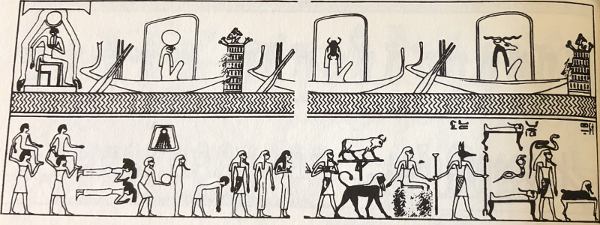The Spell of the Twelve Caves (also known as the Book of the twelve Caverns) is a New Kingdom funerary text. It depicts a series of caverns, each with a varying number of deities inhabiting them. Unlike the other major netherworld texts, there are no depictions of dangerous or threatening beings, and no references to the punishment of the guilty. Instead, the deities grant favours and offerings to the deceased.

The first seven caves are only depicted in the Osireion, and even there the inhabitants are not depicted in great detail but rather schematically in groups of three – two male mummified figures along with one female mummy).
The eighth to the twelfth caves are most often depicted in their entirety. In the Osireion the king is shown kneeling to make offerings to the gods, and the deities of the later caves are depicted individually. In other versions one deity represents the group for that section with the number of other deities in that cave noted beside or below them. The texts generally detail the offerings or favours granted by the deities (for example, Ra grants free movement for the deceased, as well as light in the netherworld, food and drink, and protection from enemies).
The first known version of the text appears on a papyrus from the tomb of Amenhotep II (Cairo CG 24742). The text and images that make up the Spell of the Twelve Caves also make an appearance in the Book of the Dead as Spell 168. Elements remained in use until the Ptolemaic Period, in the Book of Hours. The text is clearly related to other netherworld texts, and was originally viewed as part of the Book of the Dead. However, Piankoff has asserted convincingly that it should be considered as an independent composition. The text is only given a specific title, “Spell for allowing Osiris NN to enter”, in one version (Papyrus BM 10478)
Bibliography
- Hornung, Erik (1999) The Ancient Egyptian Books of the Afterlife
Copyright J Hill 2010